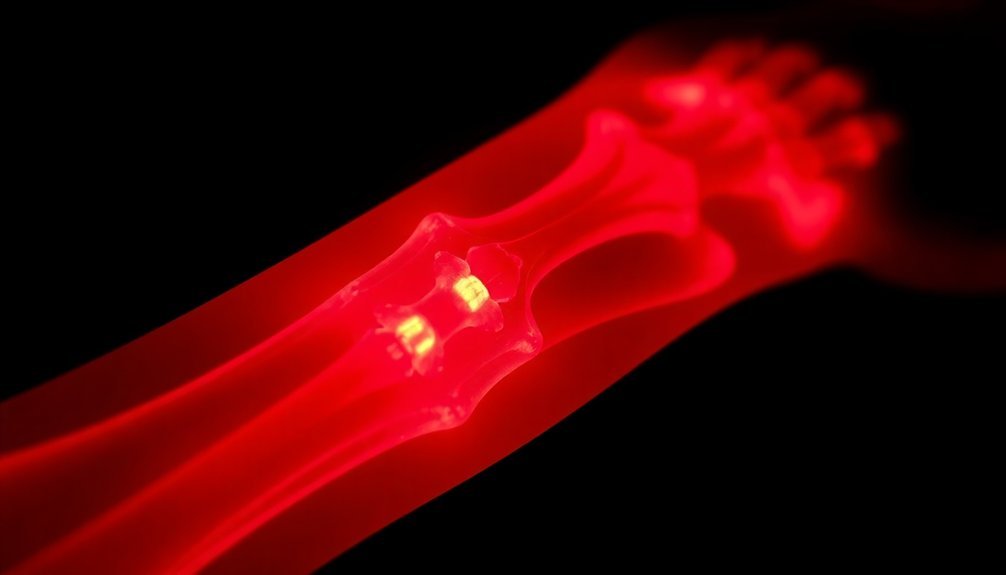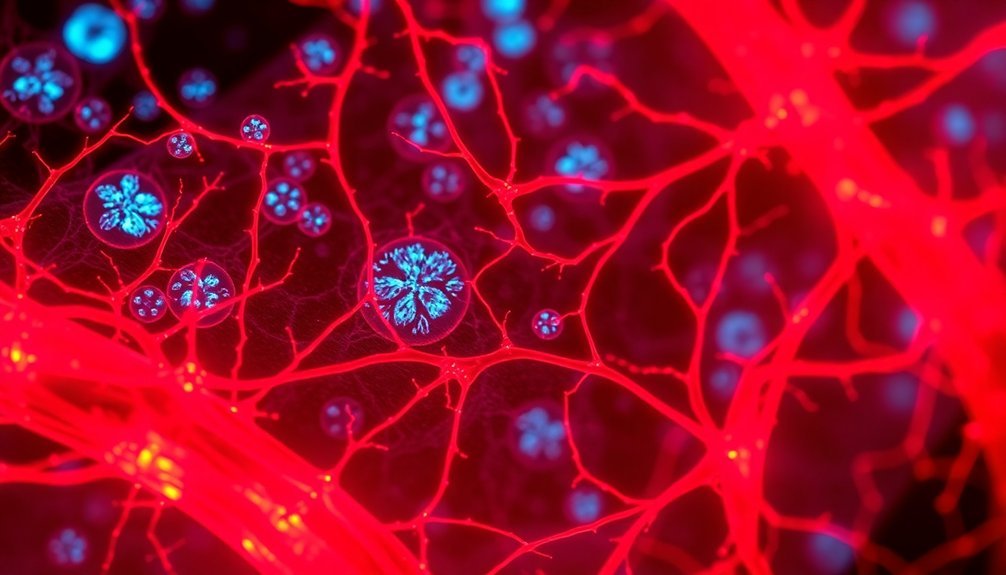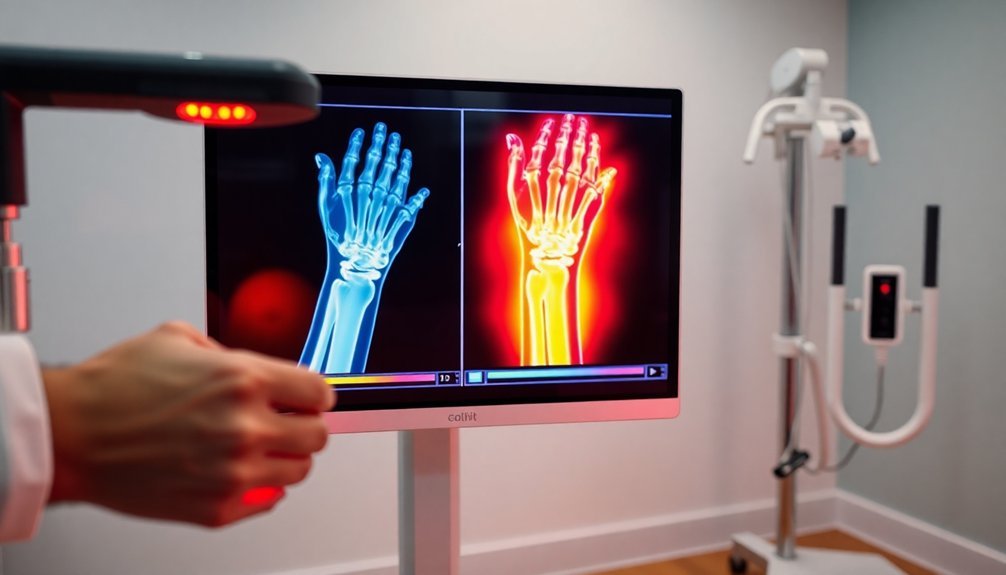Photobiomodulation (PBM) can effectively heal and strengthen your bones through targeted light therapy. When specific wavelengths of red and near-infrared light penetrate your tissues, they boost your cells' energy production and activate bone-forming cells called osteoblasts. Your body responds by increasing growth factors, forming new blood vessels, and reducing inflammation – all essential for bone repair. The therapy works at a cellular level to enhance bone density, accelerate healing, and improve overall bone strength. Studies show PBM is particularly effective when combined with other treatments, making it a valuable tool in modern bone regeneration protocols. There's much more to discover about this fascinating healing technology.
Understanding Photobiomodulation For Bone Health

Photobiomodulation (PBM) acts as a powerful therapeutic tool for promoting bone health through multiple biological mechanisms. When you undergo PBM therapy, the light energy triggers several essential processes in your bone tissue, including enhanced blood vessel formation and increased osteoblast activity.
Your bones benefit from PBM's ability to stimulate vascular endothelial growth factor, which creates new blood vessels vital for healing. It also boosts your osteoblasts' performance by increasing ATP production and activating bone growth factors. The therapy works by activating MAPK pathways that signal cells to begin the healing process.
You'll experience reduced inflammation in the treated areas, creating an ideal environment for bone regeneration.
PBM's effectiveness depends on specific parameters. You'll typically receive treatment using wavelengths between 635-980 nm, with an output power of 40-100 mW. The energy density shouldn't exceed 100 J/cm² for the best results.
While PBM shows promising results, you should know it has limitations, including restricted penetration depth.
The therapy accelerates bone formation and improves bone density through enhanced osteocyte development and bone remodeling. It's particularly effective when combined with other treatments like bioactive glasses, offering you a thorough approach to bone regeneration and strengthening.
How Light Therapy Repairs Bones
Red light therapy repairs bones through four primary mechanisms that work together to accelerate healing.
First, it stimulates bone formation by activating osteoblasts, which are cells responsible for depositing new bone material. You'll see increased bone density and improved mineralization as these cells produce more osteocalcin and bone matrix. The therapy uses low-level LED light to penetrate deep into bone tissue.
Second, it reduces inflammation at the injury site by modulating cytokine levels and improving microcirculation. This balanced inflammatory response creates a favorable environment for your bones to heal properly without excessive inflammation getting in the way.
Third, it enhances cell proliferation by stimulating various cell types essential for bone repair. You'll benefit from increased fibroblast activity, which helps synthesize collagen, while osteoblasts work harder to deposit bone matrix and form a stabilizing callus around the fracture.
Fourth, it boosts blood flow to the injured area through improved microcirculation and the formation of new blood vessels. This enhanced blood flow guarantees your healing bones receive the oxygen, nutrients, and immune cells they need for proper repair and regeneration.
Cellular Mechanisms Behind Bone Regeneration

Your body's cells kick into high gear when exposed to photobiomodulation therapy, as the light energizes your mitochondria to produce more ATP for bone regeneration.
This enhanced cellular energy production enables osteoblasts and progenitor cells to multiply faster and function more efficiently in creating new bone tissue.
The light therapy also triggers the release of essential growth factors that signal your cells to accelerate bone repair and strengthen the healing process.
The therapy stimulates mesenchymal stem cells to differentiate into bone-forming cells, establishing a foundation for new bone development.
Mitochondrial Energy Production Boost
Through a complex cascade of cellular events, the enhancement of mitochondrial energy production serves as a cornerstone in bone regeneration via photobiomodulation therapy.
When you undergo PBMT, it directly stimulates your mitochondria, leading to increased ATP synthesis through enhanced cytochrome c oxidase activity. This boost in cellular energy is vital for transforming mesenchymal cells into specialized bone-forming cells called osteoblasts.
Your body's bone healing process heavily relies on this increased ATP production, as it powers both osteoinduction and osteoconduction. The energy boost also triggers a rise in nitric oxide production, which helps regulate calcium levels within your cells and controls the inflammatory response during healing. NO's role extends to upregulating growth factors essential for creating an ideal environment for bone repair.
It's important to note that the energy levels used in PBMT substantially impact its effectiveness. You'll typically see better results with lower energy levels (around 1 J) compared to higher ones (3 J or more). This precise control of energy delivery guarantees proper osteoblastic differentiation and prevents potential negative effects that could occur with excessive energy exposure.
Cell Growth Factor Activation
Light-activated photobiomodulation initiates a complex series of cellular responses, with periosteal stem cells (PSCs) playing a central role in bone regeneration. When you undergo PBM therapy, it stimulates TRAP-positive monocytes to release Connective Tissue Growth Factor (CTGF), which activates your PSCs and directs their commitment to bone healing.
Your PSCs are more effective than bone marrow stem cells in forming new bone tissue, and they'll respond to PBM by enhancing the expression of essential growth factors. The therapy triggers a cascade of cellular activities that promote both endochondral and intramembranous bone formation.
| Growth Factor | Primary Function | Effect on Bone Healing |
|---|---|---|
| CTGF | PSC Activation | Enhances chondrogenesis |
| PDGF-BB | Angiogenesis | Couples blood vessel and bone formation |
| VEGF | Vascularization | Promotes bone remodeling |
| IGF-1 | Cell Proliferation | Accelerates bone regeneration |
| BMP | Osteogenesis | Stimulates bone formation |
PBM's ability to enhance these growth factors' expression leads to increased osteoblastic activity and improved bone healing. The therapy works by optimizing your body's natural healing mechanisms, particularly through the activation of local resident progenitor cells and the stimulation of circulating bone repair cells.
Wavelengths That Strengthen Your Bones
The most effective wavelengths for strengthening your bones fall within specific ranges, with 808 nm and near-infrared (~850 nm) showing particularly promising results for bone regeneration.
Near-infrared light penetrates deeper into your tissue, making it especially valuable for targeting bones beneath layers of skin and muscle.
These wavelengths work by stimulating osteoblastic activity, promoting collagen production, and enhancing bone mineral density through targeted photobiomodulation therapy.
Optimal Wavelength Ranges
Research has identified two key wavelength ranges that effectively strengthen bones: red light (635-660 nm) and near-infrared light (808-850 nm).
Red light, particularly at 635 nm, helps reduce bone damage by decreasing osteoclast formation and bone resorption. It's also proven effective in improving bone density around dental implants and enhancing early-stage bone healing.
Near-infrared light offers distinct advantages through its superior tissue penetration ability. At 808 nm, this wavelength promotes mitochondrial respiration and ATP synthesis while stimulating blood vessel formation. It's particularly effective at encouraging mesenchymal cells to transform into osteoblasts, which are vital for bone formation.
The 850 nm wavelength has shown remarkable results in boosting bone regeneration and collagen synthesis.
You'll want to pay attention to the energy density when using these wavelengths. Studies show that densities below 100 J/cm² are most effective, with top output powers ranging from 40-100 mW.
While both continuous and pulsed light applications can work, you'll need to maintain consistency in your treatment schedule to see results.
Benefits of Near-Infrared Light
Building on our understanding of ideal wavelengths, near-infrared light offers remarkable benefits for bone strengthening and regeneration. When you undergo near-infrared light therapy, you'll experience enhanced bone matrix synthesis and increased blood vessel formation, which are essential for ideal bone health.
You'll benefit from improved osteoblast activity, which directly leads to higher bone mineral density. The therapy boosts important biochemical markers like B-ALP and osteocalcin, indicating active bone formation.
What's particularly significant is that this treatment doesn't just support healing – it's completely non-invasive and stimulates your body's natural cellular processes.
Through photobiomodulation, you'll notice reduced inflammation and pain around affected bone areas. The therapy works by triggering specific cellular pathways that enhance osteoblastic activity and promote collagen synthesis. You'll also experience increased expression of genes related to bone formation, which accelerates the healing process.
Whether you're dealing with bone defects, osteoporosis, or general bone health maintenance, near-infrared light therapy can help. It's versatile enough to be administered in clinical settings or at home using LED devices, making it a convenient option for ongoing bone health support.
Treatment Protocol And Best Practices

Successful photobiomodulation therapy for bones relies on carefully calibrated treatment parameters and standardized protocols.
You'll get the best results with lower energy doses (around 1 J) during early stages of bone repair, using infrared wavelengths between 780-830 nm. The power settings typically range from 6 mW to 100 mW, with energy density varying from 3.6 to 254 J/cm2.
You'll need multiple treatment sessions, though there's no one-size-fits-all duration. Your healthcare provider might combine PBMT with ceramic biomaterials like hydroxyapatite to enhance bone regeneration. They'll also likely integrate other recovery techniques for muscles and joints to maximize overall healing.
Your treatment plan should be tailored to your specific condition, as different bone defects require different approaches. You'll undergo regular follow-up sessions to maintain and monitor your progress. If you're receiving treatment for dental implants or tibial bone issues, your protocol might be adjusted accordingly.
Remember that while lower doses often work better for initial bone repair, your practitioner will determine the ideal parameters based on your particular case, healing stage, and treatment goals.
Clinical Evidence For Bone Healing
Strong clinical evidence consistently demonstrates PBM's effectiveness in accelerating bone healing processes. Studies show that PBM notably enhances osteoblastic proliferation and collagen deposition, leading to faster and more efficient bone repair. You'll find that low-level laser therapy (LLLT) specifically promotes healing through enhanced callus formation and improved bone mineral density.
| Clinical Outcome | Impact on Your Health |
|---|---|
| Pain Reduction | You'll experience substantial relief with a proven 1.19 mean difference vs. placebo |
| Inflammation Control | Your healing accelerates through reduced swelling and inflammatory markers |
| Bone Regeneration | Your bones repair faster with increased osteoblast activity |
Research confirms that PBM stimulates bone regeneration regardless of the parameters and biomaterials used in treatment. You'll benefit from its ability to induce vascular sprouting, which is essential for proper bone healing. While current evidence shows promise, you should note that standardization of PBM protocols is still developing. The therapy's effectiveness in promoting bone repair is supported by considerable changes in radiographic parameters and functional disability assessments, making it a valuable option for your bone health management.
Combining PBM With Other Treatments

Innovative combinations of photobiomodulation with other therapeutic approaches substantially enhance bone healing outcomes. When you combine PBM with biomaterials, you'll see improved bone formation and better biomechanical properties, including enhanced bone mineral density and mechanical strength.
If you're undergoing guided bone regeneration (GBR), adding PBM can accelerate your healing process. Even a single PBM session with the right dose and wavelength can boost bone repair by preventing unwanted cell migration and maintaining space for bone-forming cells.
You'll notice faster recovery as PBM helps organize collagen fibers and promote bone tissue formation.
PBM works particularly well with surgical interventions, especially when using infrared lasers. You'll benefit from increased osteoblastic activity and enhanced angiogenesis, which are vital for proper bone healing. The treatment can upregulate your bone growth factors and maintain an ideal tissue environment for repair.
While combining PBM with other therapeutic agents, you'll need to take into account specific wavelengths and energy levels for the best results. Notably, combining PBM with zoledronic acid doesn't show significant advantages over using PBM alone, highlighting the importance of carefully selecting treatment combinations.
Latest Research And Medical Applications
Building on decades of clinical research, recent studies have revealed groundbreaking applications of photobiomodulation in bone regeneration and repair. Scientists have discovered PBMT's remarkable ability to enhance bone healing by boosting mitochondrial respiration and ATP synthesis while stimulating new blood vessel formation.
Research shows that low-intensity infrared laser therapy offers the most effective results for bone tissue treatment. It works by increasing osteoblast activity (cells that build bone) while inhibiting osteoclasts (cells that break down bone), leading to improved bone density and strength.
You'll be interested to know that PBMT can also enhance the transformation of adipose-derived stem cells into bone-forming cells, opening new possibilities in regenerative medicine.
Latest studies demonstrate PBMT's success when combined with materials like biphasic calcium phosphate and fibrin biopolymer. While researchers continue to fine-tune the ideal treatment parameters, they've found that lower energy levels (1 J) typically work better than higher ones (3 J) for bone repair.
Medical applications now span various specialties, from dental procedures to sports medicine, offering a non-invasive option for bone healing and strengthening.
Frequently Asked Questions
Can PBM Therapy Help Prevent Bone Loss During Space Travel?
Yes, PBM therapy can help prevent your bone loss during space travel by accelerating bone matrix synthesis, enhancing osteoblast differentiation, and promoting bone repair, which could counter the rapid bone deterioration experienced in microgravity.
Does Photobiomodulation Interact With Common Bone-Strengthening Medications or Supplements?
While research is limited, you'll be glad to know that PBMT's non-invasive nature suggests minimal interactions with bone medications. However, you should always consult your healthcare provider before combining treatments.
Are There Any Age Limitations for Receiving PBM Treatment?
While there aren't strict age limits for PBM treatment, you'll find that clinical trials often specify age ranges. However, you should always consult your healthcare provider to determine if PBM's appropriate for your specific situation.
Can PBM Therapy Help With Bone Healing After Dental Implant Surgery?
Yes, PBM therapy can help your dental implant recovery by stimulating bone regeneration, improving osseointegration, and speeding up healing. You'll experience less pain and inflammation during the post-surgery healing process.
Does PBM Treatment Work Differently for Weight-Bearing Versus Non-Weight-Bearing Bones?
Yes, PBM works differently between bone types. You'll see faster healing in weight-bearing bones due to their higher cellular metabolism, while non-weight-bearing bones require additional mechanical support for maximum PBM effectiveness.
In Summary
Photobiomodulation offers you a promising non-invasive treatment for bone healing and strength. You'll find that specific red and near-infrared wavelengths stimulate your bone cells, increase mineralization, and accelerate repair. While research continues to evolve, you can integrate PBM with traditional treatments for enhanced bone health. Remember to consult your healthcare provider to develop the right protocol for your specific bone health needs.





Leave a Reply